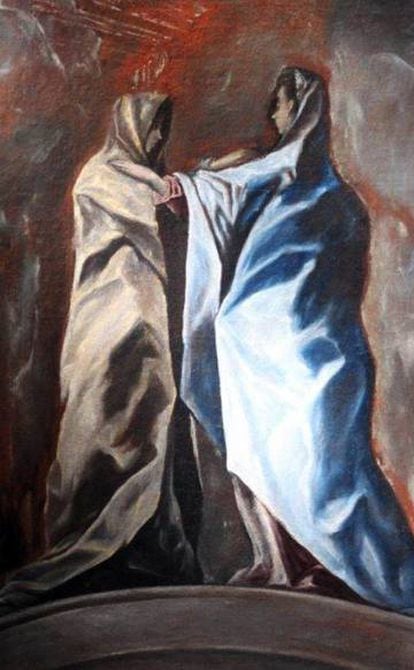Could this be a lost El Greco?
A private collector from Toledo puts a painting some believe to be by the Greek-born artist on public display


On January 10, a handful of journalists were ushered in to marvel at The Visitation, a large canvas supposedly painted by El Greco for the Oballe chapel that forms part of Toledo’s San Vicente Mártir church.
The existence of the painting that depicts the Virgin Mary greeting her cousin Elizabeth, dressed in traditional robes at the doorway to Elizabeth’s home – one pregnant with John and the other with Jesus – was revealed during The Year of El Greco in 2014. However, its owner, who prefers to remain anonymous, has still not given experts the go-ahead to examine its authenticity.
As the El Greco Museum in Toledo displayed the painting to the public, the museum’s director Juan Antonio García Castro, appeared convinced that it was an original, although he insisted that proof was needed. It is, he said “very probable” that it is the work of the artist Doménikos Theotokópoulos – otherwise known as El Greco (the Greek).
What’s the point of having a painting like that if you don’t know the artist? Juan Antonio García Castro
So far, there are several documents suggesting that the painting was completed after 1608, towards the end of the artist’s life. There is also the contract commissioning the artist with the work along with three others – one of Saint Peter, one of Saint Ildefonso and one of the Immaculate Conception – all for the Oballe chapel. There also exists a document from El Greco’s son, Jorge Manuel, who helped his father secure payment for the work.
The San Vicente Mártir church is now an all-purpose art center and the chapel a horse-shoe-shaped nook with an arch and stripped brick walls. It is not known whether the paintings were ever displayed in the chapel or if reproductions were used because there are two examples of each of the commissioned paintings scattered around the world. Supposedly, the original of the Visitation hangs in Washington, but art historian María del Mar Doval believes the work to be inferior to what was revealed in Toledo on January 10.
Doval revealed the existence of this new Visitation in a specialist publication in 2014, though she first set eyes on it 20 years ago. According to Doval, it is “perfectly conserved” and does not appear to have traveled much nor suffered in any way. Its colors appear fresh and, as far as Doval is concerned, the maestro’s hand is indisputably at work. She points out the women’s biblical capes, whose folds are not blended with the background.
Jorge Manuel devotedly brought to light all his father’s unfinished paintings upon his death
“He didn’t bother doing that which is very El Greco,” she says. Besides, the heads of the two figures – the Virgin Mary with an earring – also strike her as peculiar to the artist. “And look at the clear [red] brushstrokes in the top corner,” she urges. “They represent Elizabeth’s doorway while in the painting in Washington, the door is clearly painted with lines made with a ruler. In the last years of his life El Greco didn’t do things like that.”
But it is precisely the red in the background so often used by El Greco that has aroused the suspicions of art expert Leticia Ruiz who is currently compiling a catalogue of all El Greco paintings and where they can be found.
“This layer of red looks like it was added on purpose, as if it were done to reinforce the idea that it is an El Greco; the earring detail seems to me to be unthinkable in a late painting and the beige of Elizabeth’s clothes is very strange,” says Ruiz, who does however applaud the move to show the painting to the public. “What I find strange about the one that is exhibited in Dumbarton Oaks in Washington is the door, this is true, and I think it could have been a finishing touch done by the son Jorge Manuel, because of his dedication to architecture.”
The commissioner
Isabel de Oballe was born in Toledo but ended up fleeing to Peru, tired of the abuse she received from her father and also her son, a cocktail of violence beyond what might have been considered normal for the period. It was she who commissioned El Greco to paint the four religious works to adorn the walls of the chapel founded in the Toledo church where a painting of Elizabeth was needed, hence the Visitation.
Oballe married twice in Peru and came back to Spain to end her days in Seville, not Toledo. She told her husband to give part of her fortune to her daughters, but once she was dead, her husband married again and nothing further was heard of the inheritance.
The head of the Renaissance Department at the Prado Museum believes it could be a modern reproduction, one of the many that were produced due to the demand for El Greco’s work at the start of the 20th century. Ruiz, meanwhile, concedes that part could have been done by El Greco and finished off by a later artist, given that Jorge Manuel devotedly brought to light all his father’s unfinished paintings upon his death.
El Greco set up his studio in Toledo in 1577 and received hundreds of commissions and made good money, although he was constantly embroiled in court cases as his modernity clashed with the conservative ideas of the commissioners. Toledo was at that time one of the biggest clergy centers in Europe with 60,000 inhabitants, just 20,000 less than today. El Greco moved there in his mature period. Previously he was working in his native Candía, Crete, as well as Venice and Rome and Michelangelo’s influence is evident in some of his work.
The director of the El Greco Museum revealed that for two years they had been working towards and persuading the anonymous owner to exhibit the painting to the public. They have also been suggesting that he submit the painting to tests of authenticity. “What’s the point of having a painting like that if you don’t know the artist?” he says.
English version by Heather Galloway.












































